Drunken Noodles (Pad kee mao ผัดขี้เมา) is a Thai noodle stir fry made with your choice of protein and veggies bathed in the most irresistible Thai basil sauce that’s surprisingly quick and easy to make at home! (despite the name, there is no alcohol in the recipe 😉.)
Thai Drunken Noodles (Pad Kee Mao) is cult-favorite Thai street food and one of my personal favorite Thai dishes. Today, I’m going to teach you how to make it at home with step-by-step photos, tips and tricks and a pantry friendly sauce! This Drunken Noodles recipe is a soft tangle of chewy wide rice noodles, chicken (or sub your favorite protein), and veggies enveloped in a potent, savory, slightly-sweet, and however-spicy-you-prefer sauce, laced with plenty of aromatic basil. This Pad Kee Mao recipe boasts the big signature flavors and contrasting textures you know, love and expect from Drunken Noodles, but is made with versatile pantry friendly ingredients and YOU can customize the heat!
It’s no secret that Thai food is my favorite cuisine to eat and to make! If you’re a fan of Thai food, you’ll love my Pad See Ew, Pad Thai, Panang Curry, Thai Basil Chicken, Red Curry, Yellow Curry, Green Curry (taste the rainbow!) Thai Basil Chicken, Coconut Curry Chicken, Tom Yum Soup, Thai Noodle Soup and Tom Kha Gai.
PIN THIS RECIPE TO SAVE FOR LATER
This is a detailed post all about Thai Drunken Noodles and everything you need to know to be successful at making the recipe at home. You can read on or use the “jump to recipe” button at the top of the post to skip directly to the recipe card.

WHAT are drunken noodles?
Drunken Noodles are a popular, traditional Thai stir fry made with wide rice noodles, fresh veggies (typically onions, bell peppers, baby corn and tomatoes) and your choice of protein (ground pork, shrimp and chicken are all popular). But what truly sets Thai Drunken Noodles apart is the sauce. The noodles are doused in a fiery, tangy, slightly sweet sauce made with Thai chilies, oyster sauce, soy sauce, fish sauce, rice vinegar and sugar then bolstered with loads of brilliantly fragrant, anise flavored Thai holy basil. It’s a dizzyingly delicious combination that will leave you spellbound – and grateful you can whip up another batch in just over 30 minutes.
Where did Drunken Noodles Come From?
Thai Drunken Noodles is an Asian “fusion food” favorite. It combines the technique of stir-frying noodles borrowed from Chinese immigrants with the taste of Thailand, specifically Thai chilies and Thai holy basil.
Thai noodles dishes such as Pad Kee Mao, Pad Thai and Pad See Ew became popular in World War II when Thailand was facing a rice shortage. Rice noodles, on the other hand, were in abundance so the Thai government encouraged the substitution of rice with rice noodles. The citizens mixed rice noodles with various vegetables and proteins resulting in new inexpensive, instant classics that the world has been enjoying ever since.
Today, Drunken Noodles is one of the most popular Thai dishes in Thailand sold by street vendors and in restaurants throughout the country and in most every Thai restaurant across the United States – because it is AMAZING!
What does Drunken Noodles mean in Thai?
In the Thai language, khi mao means drunkard, so the literal translation of pad kee mao is Drunken Noodles. Despite its name, however, the dish does not contain any alcohol. Theory has it that after a full day of drinking, Thai men would come home to enjoy this dish, believing the spiciness of the magical “drunken” sauce would reduce the alcohol content in their systems and help with hangovers in the morning.
drunken noodles vs pad thai
Both Drunken Noodles and Pad Thai are popular Thai rice noodle dishes made with protein and vegetables. Pad Thai however, is characterized by its nuttiness from crushed peanuts and a tangy, subtly sweet sauce made from tamarind sauce, fish sauce and palm sugar. Pad Kee Mao, on the other hand, is characterized by its wider rice noodles, spicy Thai chilies and fragrant, anise Thai holy basil which creates a fiery, fabulously fragrant sauce. It is more savory and less sour than Pad Thai and is void of nuts. Both dishes are fabulous and unique which means you need to make them both!
pad see ew vs drunken noodles
Both Pad Sew Ew and Drunken Noodles are popular Thai dishes both made with wide rice noodles. Thai Drunken Noodles are a spicy, aromatic noodle stir-fry made with protein and a wide variety of vegetables such as baby corn, bell peppers, snow peas, tomatoes and quintessential Thai basil. In contrast, Pad See Ew typically only contains protein and Chinese broccoli. Pad See Ew sauce is made with many of the same ingredients as Pad Kee Mao, but is much milder, served with chili vinegar on the side instead of Thai chilies incorporated directly into the dish.
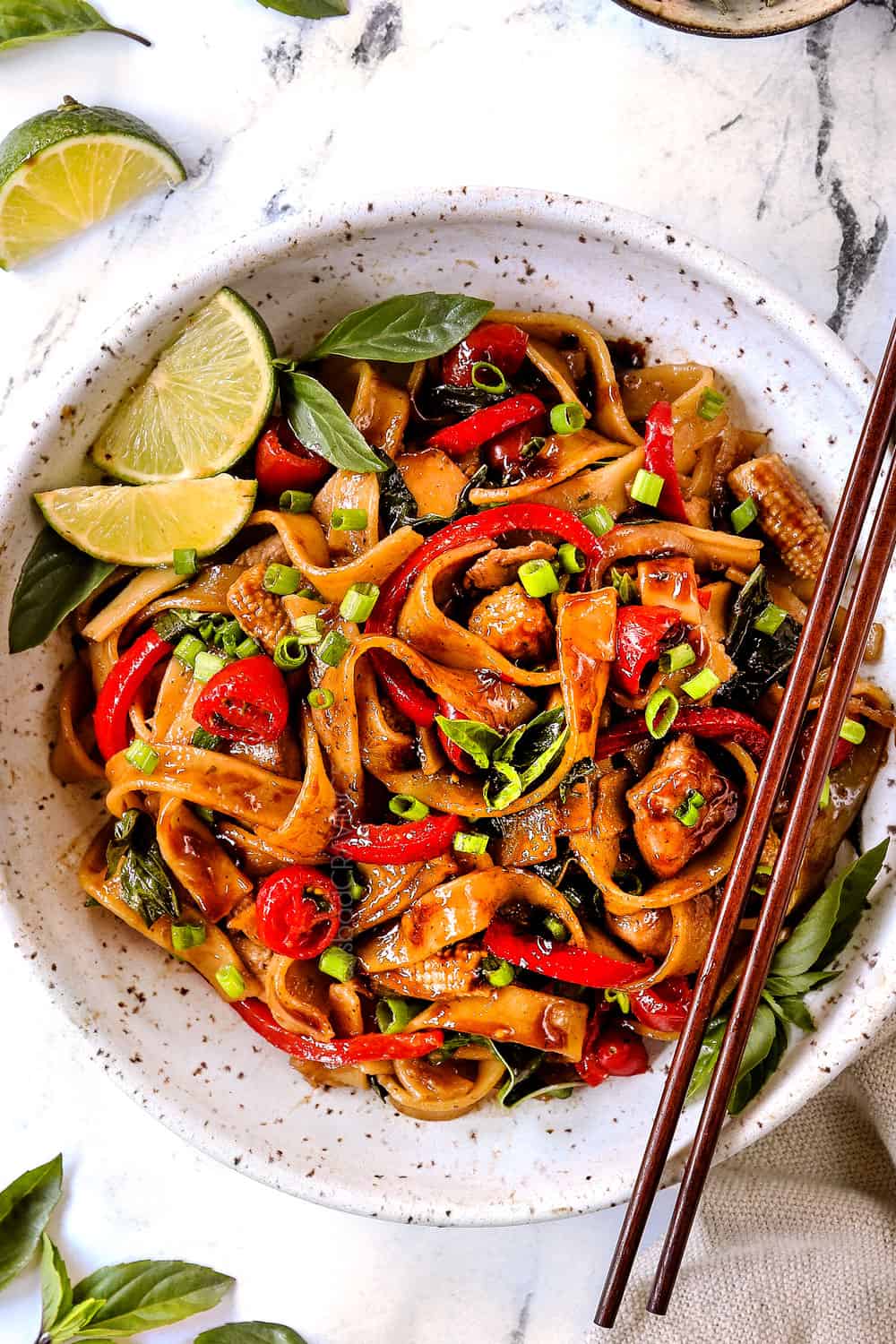
drunken noodles RECIPE
It’s no secret that I’m obsessed with Thai food, but Thailand’s famous Drunken Noodles is one of my all-time favorites. As such, it was important that I nailed this recipe, to bring you the mouthwatering balance of spicy and slightly sweet notes, and chewy, caramelized noodles. Mission accomplished. This Drunken Noodles recipe is made with more pantry friendly ingredients so it is not authentic, but it tastes like it. It rivals my favorite restaurant and is honestly better than many restaurant versions I’ve tried.
Why this recipe works:
- The sauce is to live for. That star of Drunken Noodles is the sauce. If you’ve attempted making Pad Kee Mao in the past and it wasn’t spectacular, it means your sauce recipe wasn’t spectacular. This sauce is everything it should be. The chilies bring the heat, the soy sauce and oyster sauce add the savory depth, fish sauce adds the umami richness, rice vinegar and sugar add the sweet tart notes and basil adds the fragrant, anise forward finish. Best of all, you can make this spectacular sauce with pantry friendly ingredients as detailed below.
- You get to choose the spice level. Thai Drunken Noodles is known for its heat and spicy flavor but the great thing about making it at home is you get to customize the heat! You can use less Thai chilies, swap them for serrano peppers, jalapeno peppers or use chili garlic sauce to taste. Now everyone, even the kiddos, can enjoy this Pad Kee Mao recipe with their own customized spice level.
- It doesn’t require you to purchase exotic ingredients. I wanted to create an authentic tasting sauce that boasted the adept balance of spicy, savory, sweet flavors but didn’t make you purchase two additional types of soy sauce. Authentic Drunken Noodles is typically made with Thai sweet soy sauce and dark soy sauce, along with oyster sauce, vinegar and sugar. I’ve simplified the recipe to create a sauce that’s absolutely hypnotic but pantry friendly, so you still can make Drunken Noodles any night of the week.
- The recipe is adaptable. This Pad Kee Mao recipe allows for all sorts of substitutions. In an ideal world you would make it with Thai holy basil, Thai Birdseye chilies and fresh rice noodles, but it can also be made with easy pantry friendly swaps such as regular or dried basil, garlic chili sauce and dried rice noodles or fettuccine. You can use any protein you wish instead of chicken such as ground pork, shrimp or even tofu and any veggies you heart desires or your fridge necessitates.
- It’s surprisingly quick and easy. As with all stir fries, most of the time making this Drunken Noodles recipe is in the prep. Once you’ve chopped your veggies and whisked together your sauce, it’s less than 15-minute of actual cook time all in ONE POT! Best of all, this recipe doesn’t require 30 minutes of soaking dried noodles which often end up mushy or falling apart.
Thai drunken noodles INGREDIENTS
To create an authentic tasting Thai Drunken Noodles sauce, I whipped up a cocktail of pantry friendly ingredients (pantry friendly to anyone that does much Asian cooking) to substitute for the more exotic ingredients. Thankfully, the exotic ingredients are easy to replicate. Here’s what you’ll need:
FOR THE PROTEIN
Drunken Noodles are typically made with chicken, beef, pork or shrimp but chicken is the most popular and is what I have used in this recipe. You may substitute the chicken with 12 ounces of your favorite protein (see section below).
For the chicken, I recommend chicken thighs because they are going to be cooked at relatively high heat and we don’t want them to dry out. Chicken thighs are dark meat and therefore inherently juicier and more forgiving than chicken breasts. You may use chicken breasts, but take extra care not to overcook them or you’ll have dry chicken.
The chicken thighs are tossed in a light coating of soy sauce, sesame oil and cornstarch which act as a light marinade for flavor and the cornstarch also provides a light coating that helps protect the chicken from drying out while cooking.
FOR THE DRUNKEN NOODLES SAUCE
The sauce may seem complicated, but it’s as simple as measuring out the ingredients and dumping them into a bowl. You will need:
- Oyster sauce: cannot be skipped! It is the base of almost ever stir fry sauce and adds that extra punch of flavor that cannot be replicated with other ingredients/sauces. Oyster sauce is a thick, brown sauce with a balance between sweet and salty with an earthy undertone, due to the oyster extracts. You can find oyster sauce in the Asian aisle of any supermarket for only a few dollars. Please use QUALITY oyster sauce such as Lee Kum Kee or Kikkoman. You truly can taste the difference and will be sorely disappointed with less quality brands
What if I’m allergic to shellfish? Or Vegetarian? If you’re allergic to shellfish/vegetarian, use LEE KUM KEE Vegetarian Stir-Fry Sauce instead of oyster sauce and fish sauce.
- Soy sauce + molasses + brown sugar: create an easy substitute for Thai sweet soy sauce. The soy sauce provides the saltiness, the molasses provides the signature flavor and the brown sugar provides the sweetness. Do NOT skip the molasses, it is what makes this Drunken Noodles recipe taste authentic! Make sure to use low sodium soy sauce or your recipe will be too salty.
- Fish sauce: this will not make your Pad Kee Mao taste fishy! Fish sauce is used in all Thai cooking for fabulous umami flavor. It’s like the umami of soy on steroids.
- Rice vinegar: balances the sweet and savory. Make sure to use unseasoned rice vinegar. If you don’t keep it stocked, you may substitute with white vinegar.
- Seasonings: ground coriander, ground ginger, and pepper add a depth of complex flavor and elevate this Pad Kee Mao recipe to the BEST!
FOR THE STIR FRY
- Oil: use a neutral, high smoking point oil such as vegetable or peanut oil. Do NOT use olive oil because it can burn at high heat, leaving behind a nasty taste and harmful chemicals.
- Rice noodles: fresh or dried rice noodles can be used in this recipe. I’ve detailed both of these options below. If you can’t get your hands on rice noodles, use fettuccini.
- Vegetables: half of a white onion, one red bell pepper, a handful of baby corn and half a cup grape tomatoes add flavor and textural interest. Feel free to swap in your favorite veggies of choice.
- Red Thai chilies (specifically Prik kaleang): also called Bird’s Eye or Bird pepper are a spicy chili pepper found across Southeast Asia and used in many Thai dishes. Thai chili peppers typically range from 50,000 to 100,000 Scoville Heat Units (SHU), which is, on average, 15 times hotter than a jalapeno pepper which ranges from 2,500 to 8,000 Scoville Heat Units. To tame some of the heat, you’ll want to remove all of the seeds. See substitutions below.
- Thai basil: there are actually two types of Thai Basil – regular Thai Basil and Thai Holy Basil. Drunken Noodles can be made with either, but Thai basil is easier to find at Asian grocery stores outside of Thailand.
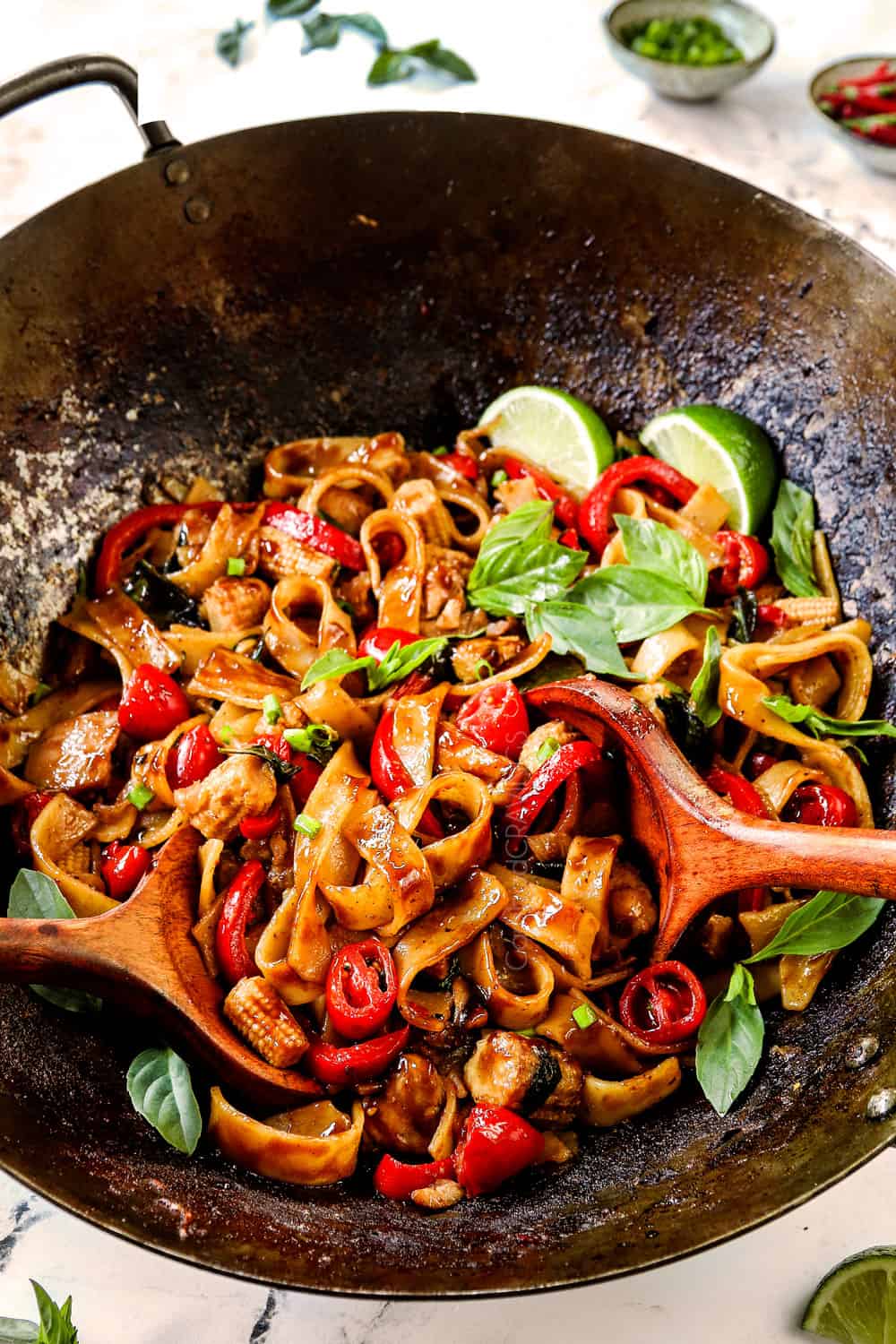
Notes about THAI BASIL
Thai holy basil is typically used in authentic Drunken Noodles in Thailand but it can be very difficult to find in the United States, so Thai basil is often substituted, even at American Thai restaurants.
Regular Thai basil should be easy to find at specialty Asian grocery stores. It tastes like normal basil with a pronounced herbal, anise-licorice flavor and crisp pungency that’s slightly more peppery than the sweet kind. Regular Thai basil is actually preferred to holy basil in many cases because it can lean towards “medicinal-tasting” with an even more pungent, fragrant licorice-like taste.
What is the best substitute for Thai basil?
Regular basil! While traditional basil, (Italian basil/sweet basil) is milder and lacks the slight anise flavor typical of Thai cuisine, it is the best substitute if you cannot get your hand on Thai basil. At some point, however, I highly suggest you source Thai basil to really bring the authentic flavor.
What if I can’t find Thai chilies or I want less heat?
If you can’t find Thai chili peppers, then you can substitute with:
- Chili garlic sauce: if you don’t like heat at all, start with less than one tablespoon chili paste. I would say 1 tablespoon is about a 3 on the heat scale at a Thai restaurant, which is what most people order. To taste the heat, go with 1 ½ -2 tablespoons and then add more to taste.
- Cayenne peppers: 30,000 to 50,000 SHU, which means they are, on average, half as spicy as Thai chili peppers. I would start with 4 deseeded, minced cayenne peppers and add more to taste.
- Serrano peppers: 10,000 to 23,000 SHU, which means they are, on average, 5 times less spicy than Thai chili peppers. I would start with 5 deseeded, minced serrano peppers and add more to taste.
- Red pepper flakes or ground cayenne pepper: can be added to taste.
HOW TO CUSTOMIZE Drunken Noodles SAUCE
It’s important to taste the sauce so it can be adjusted to your personal preferences, but keep in mind the flavor will tone down a bit once combined with the noodles and chicken. To adjust your sauce:
- for extra tang, add additional rice vinegar
- for sweeter, add additional brown sugar
- for saltier, add additional fish sauce
what noodles are used for Drunken Noodles?
Thai Drunken Noodles are made with flat, extra wide, rice noodles known as Sen Yai. The noodles give the Pad Kee Mao its wonderfully soft and delicately chewy characteristic texture. Rice noodles are made from rice flour and designed to absorb a good bit of the sauce they’re cooked in all while maintaining their perfectly al dente texture. The best part about rice noodles is that both fresh and dried varieties work well in this recipe:
FRESH WIDE RICE NOODLES
Fresh wide rice noodles are the classic noodles used for Pad Kee Mao. They come pre-cooked with a tender, silky, springy texture. You will simply add them to the recipe when it calls for stir frying the noodles.
Unfortunately, fresh wide rice noodles have a few down sides. They will require an extra trip to purchase at an Asian market, and even then, they might not carry them. If you’re successful, they will need to be used within 48 hours. Also, fresh wide rice noodles can be more difficult to work with/more delicate than dried rice noodles and are prone to breakage.
DRIED WIDE RICE NOODLES
Dried wide rice noodles make a welcome accessible substitute for fresh rice noodles, plus they keep for longer than just a couple days. To use, they will need to be soaked/cooked in boiling water and drained before stir frying. Once rehydrated, they’re essentially Sen Yai noodles – just not quite as wide.
Your grocery store will probably sell thin rice noodles (vermicelli) and 1/4-inch-wide rice noodles, often called “Pad Thai” rice noodles. You’ll want to purchase the 1/4-inch-wide rice noodles or even wider if they have them.
If you want more authentic extra wide rice noodles like the ones pictured in this recipe (still not as wide as Sen Yai though), then you may need to purchase them on Amazon. The Amazon noodles I used are A Taste of Thai Extra Wide Straight Cut Dried Rice Noodles. They are ⅜ of an inch (⅛ wider than Pad Thai Noodles) and give the dish a more authentic mouth feel. In fact, America’s Test Kitchen rated them the best dried wide rice noodles, with superior charring ability – exactly what we want in this recipe!
HOW TO PREPARE FRESH RICE NOODLES
Fresh, wide rice noodles are authentic in Drunken Noodles but they can be a very temperamental and prone to breaking. Here’s a few tips and tricks to work with them:
- Don’t fuss with cold noodles: before you warm the noodles, don’t attempt to break them apart. Cold noodles are stiff and prone to breaking, so handle them as little as possible.
- Warm the noodles: you don’t want to use cold noodles because they are less flexible and will break more easily in the stir fry. Instead, make sure your fresh rice noodles are at room temperature by either 1) transferring the noodles to a microwave safe dish, drizzling with a couple of tablespoons of water, covering with a damp paper towel and microwaving for 20 seconds or until warm; 2) transferring the fresh rice noodles from the refrigerator to a colander and quickly running hot tap water over them. Be sure to shake off any excess water and use them immediately.
- Flip don’t stir fry noodles: the more you handle the noodles, the more likely they are to break. Instead of stir frying, gently turn the noodles to combine with the sauce then flatten them against the wok to caramelize. This will prevent breakage and beautifully char the noodles.
HOW TO COOK DRied RICE NOODLES
Have you ever had Pad Kee Mao with mushy rice noodles?! It completely ruins the experience; the noodles must be characteristically chewy! Luckily, this is easy to accomplish with dried rice noodles. In fact, I find dried rice noodles are much easier to work with than fresh with less breakage because I am able to control how pliable they are before they are stir-fried – and bonus they are available at every grocery store!
The problem I encountered with dried rice noodles is that every brand recommends different soaking times accompanied by vague instructions such as “cover with hot tap water for 30 minutes” – but how hot is hot? Plus, 30 minutes is way too long to wait for a weeknight meal that otherwise is a super quick cook.
To eliminate most of the guess work, I found that covering the noodles in boiling hot water for about 15 minutes was the ticket. You’ll want to stir the noodles once the boiling water is added and then a few times while they soak to prevent them from sticking together. Then drain the noodles thoroughly, rinse with cold water to remove the loose surface starch and toss them with a little bit of sesame oil for some extra nonstick insurance and for an extra layer of flavor.
As far as the 12-15 minute approximation, check the noodles at 12 minutes then continue to soak if needed. You want the noodles to be limp and pliable, but still slightly firm and slightly crunchy because they will continue to cook with the sauce. Once you add the sauce to the noodles in the wok, you can cook them to your desired texture.
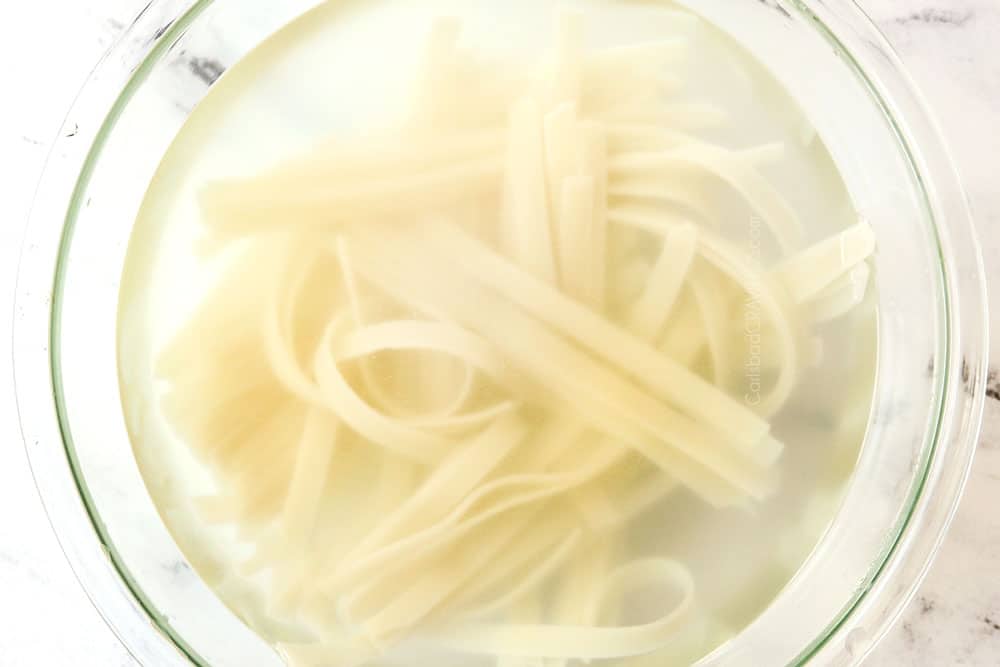
WHAT PAN SHOULD I USE? Do I have to use a Wok?
If you have a wok, then it is ideal for this Pad Kee Mao recipe because it can safely reach high temperatures to char the ingredients. If you don’t have a wok, you will want to use a large nonstick skillet, NOT stainless-steel or cast iron like I commonly use in stir fries. The noodles are extremely sticky and will stick and break against any other pan that’s not nonstick unless you use an exorbitant amount of oil which will make your Drunken Noodles unappetizingly greasy.
Instead, a nonstick skillet can still deliver a successful, charred, caramelized stir fry by stirring the ingredients less and letting them nicely brown.
HOW TO MAKE drunken noodles
Traditionally, Pad Kee Mao is made in a wok over high powered gas burners that far exceed the ability of the humble kitchen stove. The extremely high temperature allows all of the ingredients to cook in one pan at once to achieve that signature charred flavor. At home, however, our stoves are limited, but we can still maintain high heat levels by decluttering our pans and cooking the Drunken Noodle ingredients in stages. Here’s how:
(Note: the full recipe with ingredient measurements is located at the bottom of the post.)
STEP 1 – MARINATE CHICKEN
- I use the word “marinate” very loosely. You are simply combining the chicken with a splash of soy sauce, a splash of sesame oil and cornstarch and setting aside while you prep the rest of your ingredients.
- This step of flavoring the chicken is important because the chicken isn’t added to the stir fry until the very end and so it won’t soak in a lot of the sauce – it needs to be independently seasoned.
STEP 2 – MAKE the SAUCE
- The sauce is easy to make with a quick whisking of pantry friendly ingredients in a small bowl. You’ll need oyster sauce, soy sauce, brown sugar, rice vinegar, fish sauce, molasses, ground coriander, ground ginger and pepper.

STEP 3– STIR FRY chicken and veggies
- First, stir fry the chicken, onions and chilies for a couple minutes.
- Next, add the bell peppers, corn and garlic and stir fry another two minutes.
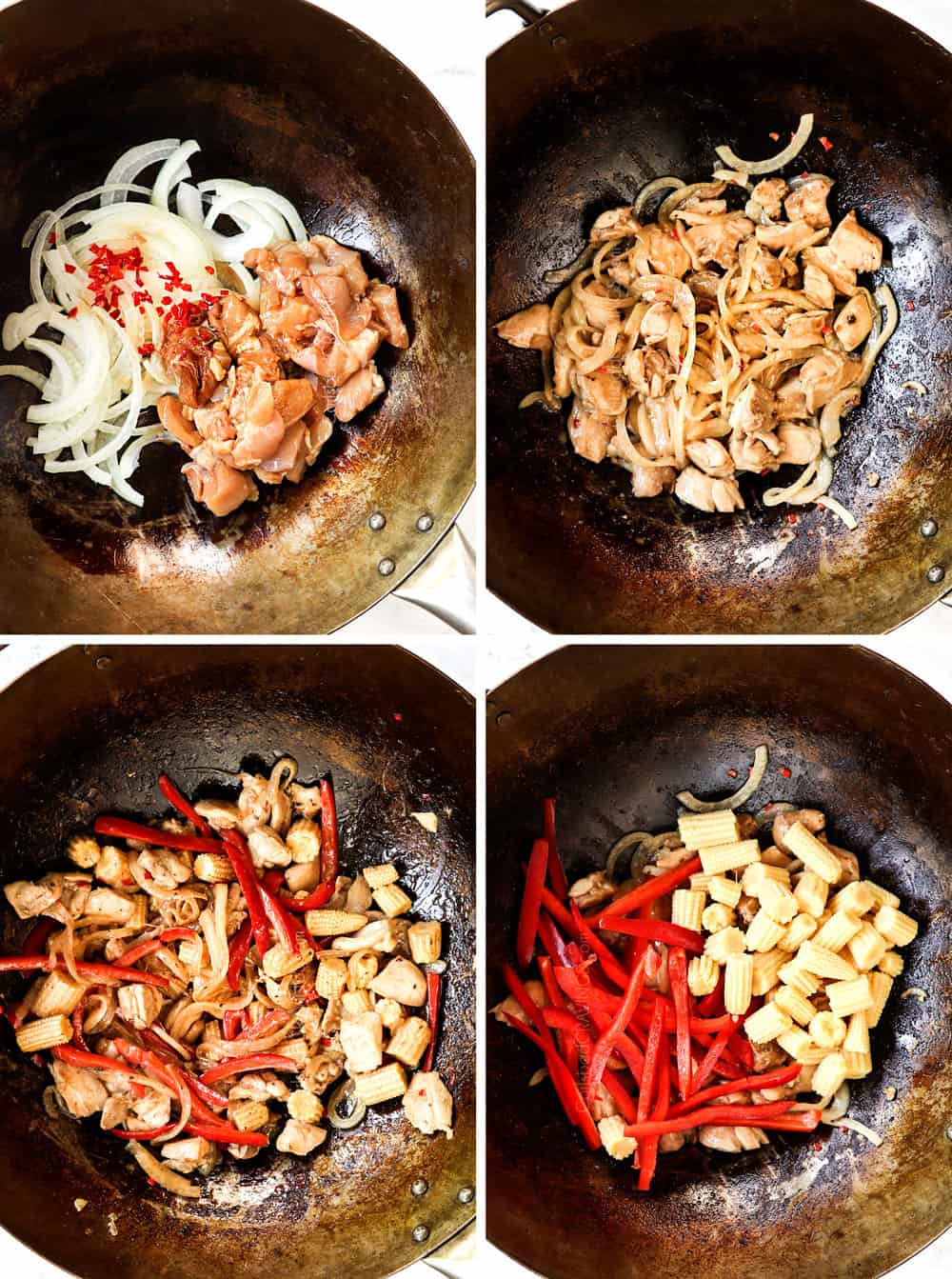
STEP 4 – CARAMELIZE the NOODLES
- Now the magic happens! Add a splash of oil so the noodles don’t stick to the pan.
- Add the noodles and sauce to the pan and toss to combine. Spread the noodles over the surface of the pan and let them sit without touching for about 30 seconds.
- Flip/stir the noodles and spread them out again; repeat 2-3 times until the noodles soak up the sauce, start to caramelize and reach desired tenderness.

STEP 5 – add the basil
- Add the tomatoes and basil and toss to combine; stir fry another 1 minute.
- Serve immediately with optional garnishes such as sliced Thai chilies, fresh basil, etc.
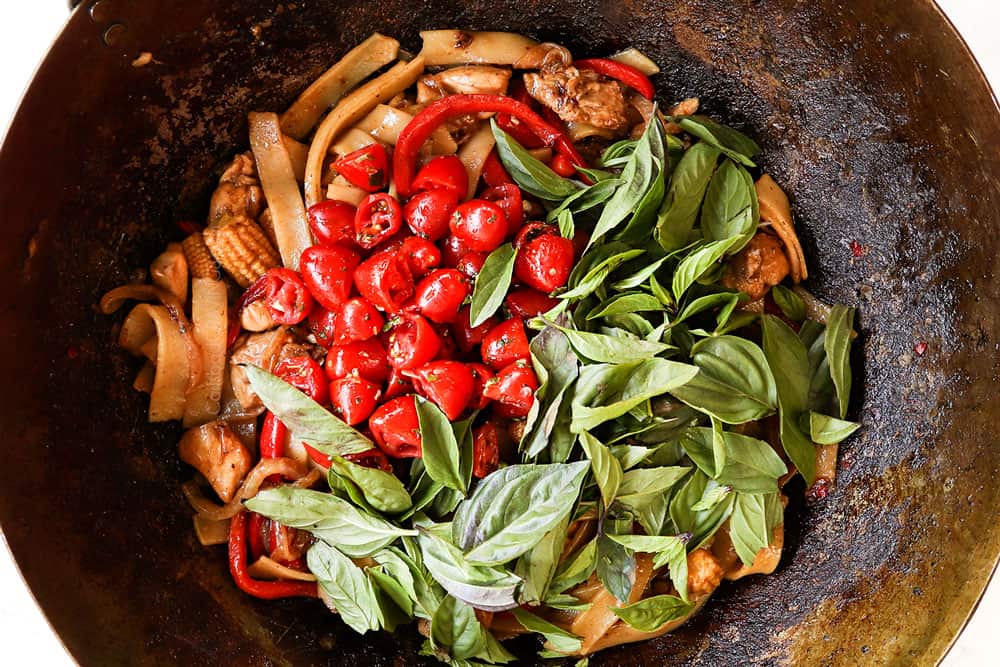
TIPS FOR SUCCESSFUL drunken noodles recipe
- As previously discussed, don’t overcook/soak your rice noodles. You want them al dente verses soft because they will continue to cook in the stir fry.
- For maximum efficiency, use the time while the chicken is marinating and the noodles are soaking to whisk together your stir fry sauce ingredients and chop veggies.
- Prep the sauce, chicken and veggies before you start cooking because the stir fry process just takes minutes – there isn’t time to stop and prep ingredients.
- Customize the spice level by using less chilies or less chili sauce. If you are worried about heat, it’s best to start with less than add chili sauce or red pepper flakes to taste.
- Feel to customize this Pad Kee Mao to make it your own – swap the protein, veggies, etc. per variations below.
Pad Kee Mao RECIPE VARIATIONS
I love that making Pad Kee Mao at home allows you to customize the heat, use different vegetables or proteins and make it tangier, sweeter or more savory.
- Swap veggies: add whatever veggies you have in your fridge to the stir fry such as mushrooms, carrots, broccoli, bean sprouts, etc.
- Make it gluten-free: use gluten-free tamari in place of the soy sauce and gluten-free oyster sauce. The rice noodles are gluten free (but as always, double check the packaging).
- Shrimp Drunken Noodles: use 12 ounces peeled, deveined medium shrimp. Toss the shrimp with the soy sauce and sesame oil like the chicken but omit the cornstarch. Cook the shrimp separately from the onions, just until opaque, about 3 minutes, then transfer to a plate. Don’t add back to the work/skillet until ready to combine at the very end.
- Beef Drunken Noodles: use 12 ounces flank steak or top sirloin sliced into thin strips. Whisk together the soy sauce, sesame oil and 1 teaspoon cornstarch in a medium bowl then add the steak and stir to combine; let marinate while you prep the ingredients. Heat 1 tablespoon oil in the skillet over high heat. Add the beef to the skillet without the onions and line in a single layer and sear for 1 minute, flip and sear the other side. Transfer beef to a plate.
- Pork Drunken Noodles: use 12 ounces pork tenderloin sliced into thin strips. You’ll treat the pork tenderloin very similarly to the steak. Whisk together the soy sauce, sesame oil and 1 teaspoon cornstarch in a medium bowl then add the pork and stir to combine; let marinate while you prep the ingredients. Heat 1 tablespoon oil in the skillet over high heat. Add the pork and stir fry without the onions just until cooked through. Transfer to a plate.
- Ground Pork Drunken Noodles: use 12 ounces ground pork. Brown the pork while seasoning with the soy sauce and sesame oil (skip the cornstarch). Add the browned pork back to the skillet with the sauce and noodles.
- Vegetarian Drunken Noodles: use extra-firm tofu. Start by draining excess moisture from the tofu by placing it in a pie plate, topping with a heavy plate and weighing down with 2 heavy cans (to release water). Set aside for 10 minutes then cut into ½-inch cubes and toss with the soy sauce and sesame oil.
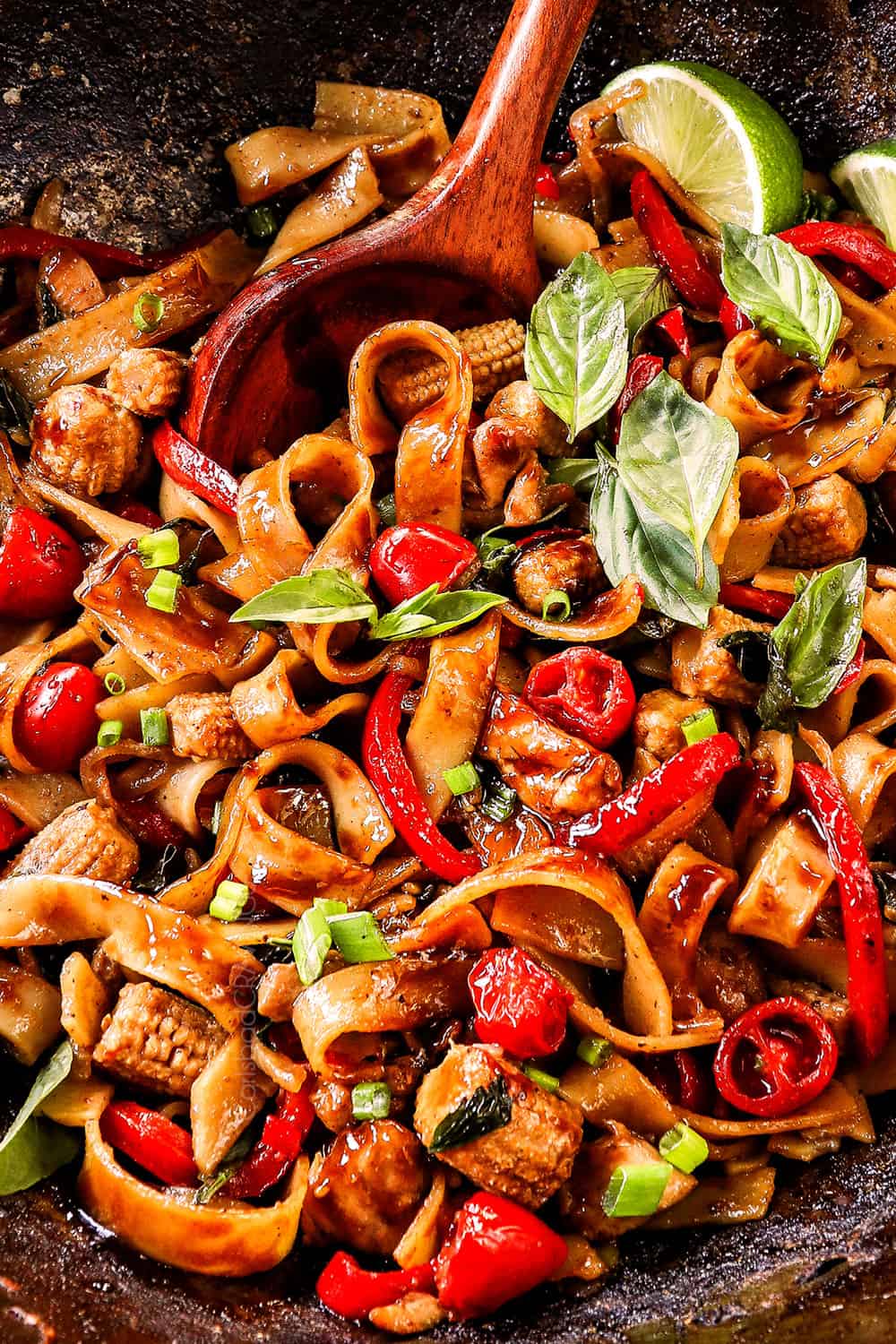
HOW TO STORE AND REHEAT drunken noodles RECIPE
- Storage: Thai Drunken Noodles are best eaten fresh because the noodles will continue to soak up the sauce until there’s no sauce left! The leftovers will be very flavorful and the noodles will still be chewy but they aren’t as appetizing because they taste drier. Still, leftovers can be stored in an airtight container in the refrigerator for up to 5 days.
- Microwave: transfer servings to a microwave-safe plate and splash with some water to add some moisture back to the dish. Cook for one minute, stir, then continue to heat at 30 second intervals until warmed through.
- Stove: reheat noodles gently over medium-low heat in a large skillet until warmed through, adding a splash of water or oil as needed.
CAN I FREEZE Pad Kee Mao?
No, Pad Kee Mao should not be frozen because rice noodles do not freeze well once combined with the sauce and will become an unpleasant texture when thawed.
WHAT CAN I PREP AHEAD OF TIME?
You can prep all of the ingredients for this Pad Kee Mao recipe ahead of time so it can literally come together in minutes:
- Noodles: soak the noodles, rinse and drain, then toss with a drizzle of sesame oil. Store in an airtight container/plastic bag in the refrigerator for up to one week. Warm in the microwave for 20 seconds before using.
- Sauce: whisk the sauce ingredients together and store it in an airtight container in the refrigerator. Let the sauce sit at room temperature while preparing the stir-fry; whisk again before using.
- Veggies: chop the veggies and store in an airtight container in the refrigerator for up to 2 days.
- Cook! Within the next 48 hours, proceed to cook the Thai Drunken Noodles in minutes!
WHAT DO YOU EAT WITH DRUNKEN NOODLES?
Drunken Noodles is a meal-in-one complete with protein, veggies and starch, so it really doesn’t need much – if anything – to flush out the meal. Still, we love serving it with egg rolls for a complete Asian feast. It is also tasty with:
- Appetizers: we love mixing and matching our favorite Thai noodles with appetizers from all over Asia such as Spring Rolls, Chicken Lettuce Wraps, Pineapple Cream Cheese Wontons, Crab Rangoons, Chicken Satay, Potstickers, Pork Egg Rolls, Sesame Chicken Egg Rolls, Sweet and Sour Chicken Egg Rolls and Chinese Chicken Wings.
- Soup: let the Asian feast continue with soup! I love to warm up to Tom Yum Soup, Tom Kha Gai, Laksa, Curried Butternut Squash Soup and Thai Noodle Soup.
- Salad: is a refreshing, bright side to the savory Pad Kee Mao. Some of our favorite Asian inspired salads include Ramen Noodle Salad, Crunchy Asian Salad, Chinese Salad, and Asian Pineapple Salad.
- Fruit: fresh fruit such as chopped pineapple is always an easy, welcome sweet stir fry side. Grilled Pineapple, Summer Fruit Salad, Perfect Fruit Salad, Creamy Grape Salad, and Pina Colada Fruit Salad are also fantastic.
MORE ASIAN NOODLE DISHES TO TRY
- Pad See Ew: is the perfect way to use your remaining 8 ounces of wide rice noodles from your Drunken Noodles recipe! Pad Dee Ew is made with wide rice noodles, crisp tender Chinese broccoli and soft eggs enveloped in a light, salty, savory sauce with a kiss of sweetness, a kiss of sour and a kiss of that irresistible charred smokiness.
- Pad Thai: a popular classic with rave reviews made with chicken, veggies, and peanuts smothered in the most irresistible savory, sweet, salty, sour sauce.
- Singapore Noodles: are a popular Chinese dish from Hong Kong characterized by their curry infused rice noodles, juicy shrimp, vegetables and eggs, all bathed in a light umami, garlic, ginger sauce laced with fragrant curry.
- Yakisoba: is a popular Japanese noodle stir fry loaded with juicy chicken, julienned carrots, thinly sliced cabbage, crunchy bell peppers and aromatic garlic, ginger and green onions bathed in a fruity, spicy, sweet and tangy sauce. This dish is also a 30-minute meal!
- Spicy Korean Noodles: are a glass noodle stir fry loaded with tender beef, mushrooms, carrots, onions and bell peppers all bathed in a spicy soy, ginger, garlic sesame sauce. One of my favorite Asian noodles of all time!
- Coconut Curry Rice Noodles: uses thin rice vermicelli tossed in an aromatic curry sauce made with coconut milk and spiked with red curry, ginger, garlic, basil and lime juice. It’s super pantry friendly and comes together in just over 35 minutes.
- Vietnamese Noodles: are made with seasoned rice vermicelli noodles, juicy lemongrass chicken, fresh slivered vegetables and garnished with crunchy peanuts and fresh cilantro all drizzled with bright and tangy Vietnamese rice vinegar dressing. These Vietnamese Noodles are light yet comforting and make fantastic meal prep bowls.

WANT TO TRY THIS drunken noodles RECIPE?
PIN IT TO YOUR asian, thai, chicken or dinner bOARD TO SAVE FOR LATER!
FIND ME ON PINTEREST FOR MORE GREAT RECIPES! I AM ALWAYS PINNING :)!
©Carlsbad Cravings by CarlsbadCravings.com
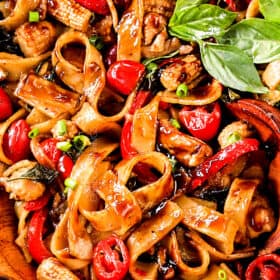
Drunken Noodles (Pad Kee Mao)
Save This Recipe To Your Recipe Box
You can now create an account on our site and save your favorite recipes all in one place!
Ingredients
CHICKEN
- 12 ounces chicken thighs, chopped into bite size pieces
- 1 tablespoon reduced sodium soy sauce
- 1 teaspoon toasted sesame oil
- 1 teaspoon cornstarch
SAUCE
- 3 tablespoons oyster sauce
- 3 tablespoons reduced sodium soy sauce
- 2 tablespoons dark brown sugar (may sub light)
- 1 tablespoon fish sauce
- 1 tablespoon rice vinegar
- 1 teaspoon molasses *don’t skip!
- 1/2 tsp EACH ground coriander, ground ginger
- 1/4 teaspoon pepper
NOODLE STIR FRY
- 3 tablespoons vegetable or peanut oil, divided
- 8 ounces wide rice noodles, fresh or dried
- 2-3 Birdseye/Thai chili peppers, deseeded and finely chopped (see notes for substitutions)
- ½ medium white onion, thinly sliced
- 1 red bell pepper, thinly sliced
- 6 ounces baby corn, halved
- 4 cloves garlic, minced
- 1 cup Thai basil leaves, loosely packed (may sub regular basil)
- ½ cup grape tomatoes, halved
Instructions
PREP
- Chicken: Whisk together 1 tablespoon soy sauce, 1 teaspoon sesame oil and 1 teaspoon cornstarch in a medium bowl. Add chopped chicken and toss to evenly coat; set aside.
- Noodles (skip this step if using fresh noodles): Place the wide rice noodles in a large bowl and pour boiling water over top until completely submerged and give them a good stir. Let them soak until softened, pliable, and limp but not fully tender/still al dente, stirring occasionally so they don’t stick together, about 12-15 minutes (less for thinner noodles). Rinse noodles in cold water, while separating any stubborn noodles with your fingers. Drain and toss with 1 teaspoon sesame oil. Set aside.
- Sauce: Whisk all of the Sauce Ingredients together in a medium bowl; set aside.
STIR FRY
- Heat 2 tablespoons vegetable oil in a wok over high heat or large nonstick skillet over medium-high heat. Once very hot, add chicken, onion, and chilies and cook for 2-3 minutes. Add bell peppers, corn and garlic and stir fry 2-3 minutes.
- Leave the chicken mixture in the pan. IF USING A WOK, add 1 Tablespoon additional oil and heat over high heat. IF USING A NONSTICK SKILLET, heat 1 teaspoon additional oil over medium-high heat (the oil helps prevent the noodles from sticking).
- Add the noodles and sauce to the pan and toss to combine. Spread the noodles over the surface of the pan and let them sit without touching for about 30 seconds. Flip the noodles and spread them out again; repeat 2-3 times until the noodles soak up the sauce, start to caramelize and reach desired tenderness.
- Add the tomatoes and basil and toss to combine. Stir fry another 1 minute. Serve immediately.
Notes
What if I can’t find Thai chilies or I want less heat?
- Chili garlic sauce: if you don’t like heat at all, start with less than one tablespoon chili paste. I would say 1 tablespoon is about a 3 on the heat scale at a Thai restaurant, which is what most people order. To taste the heat, go with 1 ½ -2 tablespoons and then add more to taste.
- Cayenne peppers: 30,000 to 50,000 SHU, which means they are, on average, half as spicy as Thai chili peppers. I would start with 4 deseeded, minced cayenne peppers and add more to taste.
- Serrano peppers: 10,000 to 23,000 SHU, which means they are, on average, 5 times less spicy than Thai chili peppers. I would start with 5 deseeded, minced serrano peppers and add more to taste.
- Red pepper flakes or ground cayenne pepper: can be added to taste.
More TIPS AND TRICKS
- Oyster/fish sauce substitute: If you’re allergic to shellfish/vegetarian, use LEE KUM KEE Vegetarian Stir-Fry Sauce instead of oyster sauce and fish sauce.
- Soy sauce + molasses + brown sugar: create an easy substitute for Thai sweet soy sauce. Do NOT skip the molasses, it is what makes this recipe taste authentic! Use low sodium soy sauce or your noodles will be too salty.
- What noodles to use: Drunken Noodles is made with fresh, flat, extra wide, rice noodles which can be difficult to find. A welcome accessible substitute is dried wide rice noodles. You’ll want to purchase the 1/4-inch wide rice noodles (often called “Pad Thai” Rice Noodles) or even wider if you can find them. The Amazon noodles I used are A Taste of Thai Extra Wide Straight Cut Dried Rice Noodles. They are ⅜ of an inch (⅛ wider than Pad Thai Noodles) and give the dish a more authentic mouth feel. In fact, America’s Test Kitchen rated them the best dried wide rice noodles, with superior charring ability – exactly what we need!
- Don’t overcook dry rice noodles: check the noodles at the 12 minute soaking mark then continue to soak if needed. You want the noodles to be limp and pliable, but still slightly firm and slightly crunchy because they will continue to cook with the sauce. Once you add the sauce to the noodles in the wok, you can cook them to your desired texture.
- Warm fresh rice noodles: to reduce breakage of fresh rice noodles, bring them to room temperature before stir frying by 1) transferring the noodles to a microwave safe dish, drizzling with a couple of tablespoons of water, covering with a damp paper towel and microwaving for 20 seconds or until warm; or 2) transferring the fresh rice noodles from the refrigerator to a colander and quickly running hot tap water over them. Be sure to shake off any excess water and use them immediately.
- Use the correct pan: a wok is ideal for this recipe because it can safely reach high temperatures to char the ingredients. If you don’t have a wok, you will want to use a nonstick skillet, NOT stainless-steel or cast iron like I commonly use in stir fries. The noodles are extremely sticky and will stick and break against any other pan that’s not nonstick unless you use an exorbitant amount of oil which will make your noodles unappetizingly greasy.
- Storage: Drunken Noodles are best eaten fresh because the noodles will continue to soak up the sauce until there’s no sauce left! The leftovers will be very flavorful and the noodles will still be chewy but they aren’t as appetizing because they taste drier. Still, leftovers can be stored in an airtight container in the refrigerator for up to 5 days. Microwave or warm in a skillet with a splash of water to add some moisture back to the dish.
VARIATIONS/DIFFERENT PROTEINS
- Swap veggies: add whatever veggies you have in your fridge to the stir fry such as mushrooms, carrots, broccoli, bean sprouts, etc.
- Make it gluten-free: use gluten-free tamari in place of the soy sauce and gluten-free oyster sauce. The rice noodles are gluten free (but as always, double check the packaging).
- Shrimp Drunken Noodles: use 12 ounces peeled, deveined medium shrimp. Toss the shrimp with the soy sauce and sesame oil like the chicken but omit the cornstarch. Cook the shrimp separately from the onions, just until opaque, about 3 minutes, then transfer to a plate. Don’t add back to the work/skillet until ready to combine at the very end.
- Beef Drunken Noodles: use 12 ounces flank steak or top sirloin sliced into thin strips. Whisk together the soy sauce, sesame oil and 1 teaspoon cornstarch in a medium bowl then add the steak and stir to combine; let marinate while you prep the ingredients. Heat 1 tablespoon oil in the skillet over high heat. Add the beef to the skillet without the onions and line in a single layer and sear for 1 minute, flip and sear the other side. Transfer beef to a plate.
- Pork Drunken Noodles: use 12 ounces pork tenderloin sliced into thin strips. You’ll treat the pork tenderloin very similarly to the steak. Whisk together the soy sauce, sesame oil and 1 teaspoon cornstarch in a medium bowl then add the pork and stir to combine; let marinate while you prep the ingredients. Heat 1 tablespoon oil in the skillet over high heat. Add the pork and stir fry without the onions just until cooked through. Transfer to a plate.
- Ground Pork Drunken Noodles: use 12 ounces ground pork. Brown the pork while seasoning with the soy sauce and sesame oil (skip the cornstarch). Add the browned pork back to the skillet with the sauce and noodles.
- Vegetarian Drunken Noodles: use extra-firm tofu. Start by draining excess moisture from the tofu by placing it in a pie plate, topping with a heavy plate and weighing down with 2 heavy cans (to release water). Set aside for 10 minutes then cut into ½-inch cubes and toss with the soy sauce and sesame oil.

Did You Make This Recipe?
Tag @CarlsbadCravings and Use #CarlsbadCravngs
Leave a Review, I Always Love Hearing From You!
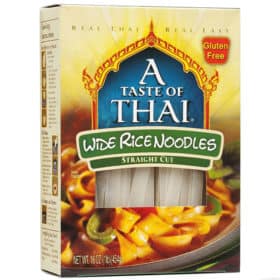
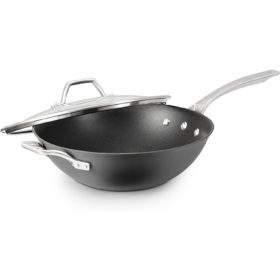
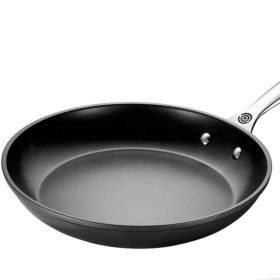
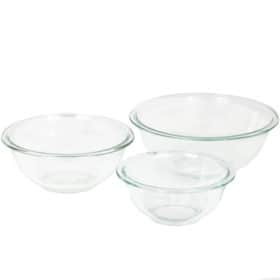
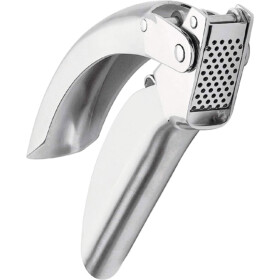
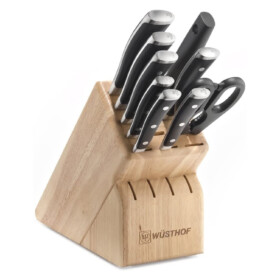
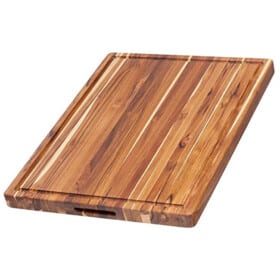
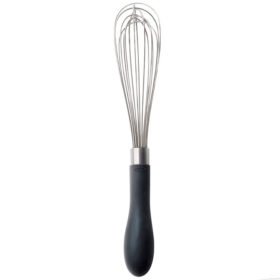
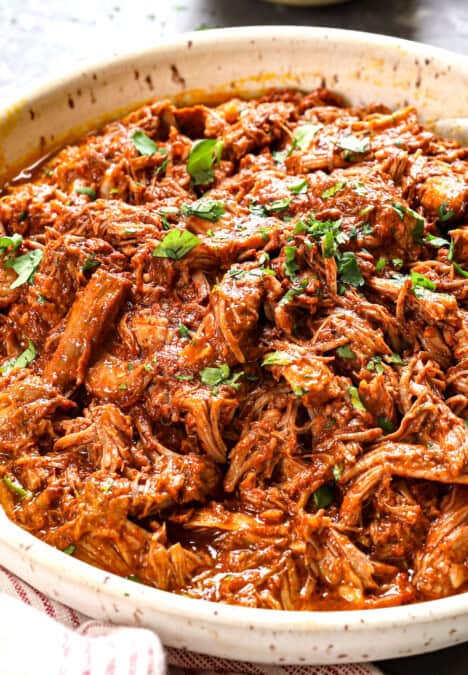
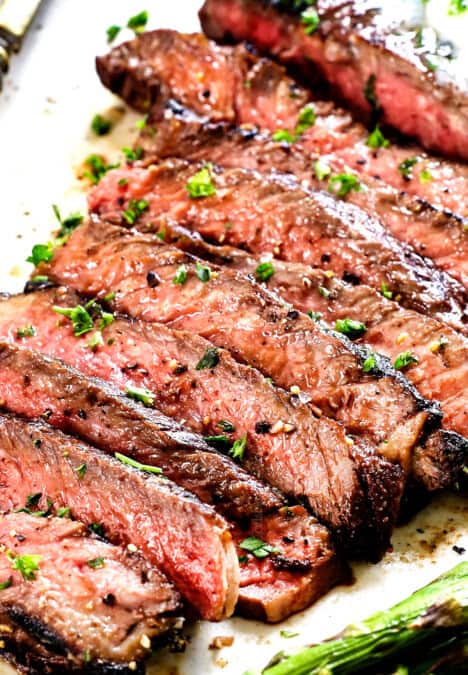
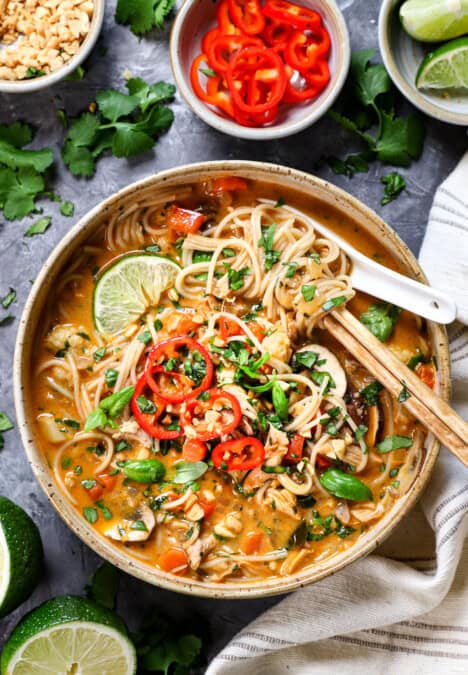

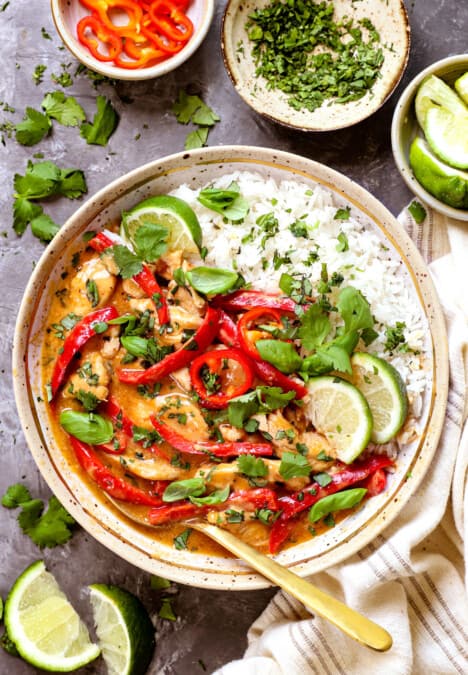
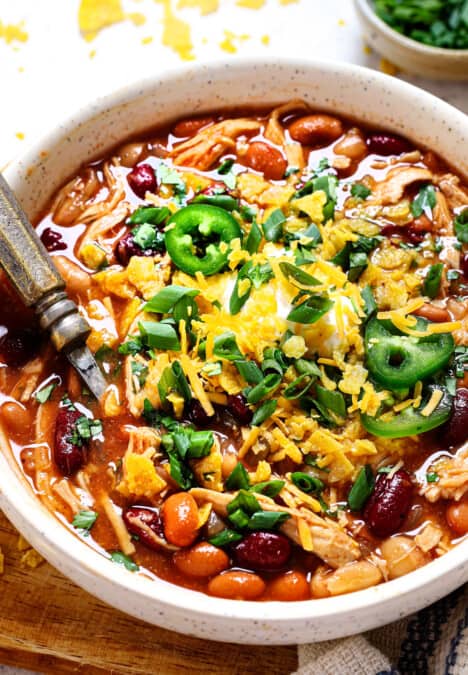

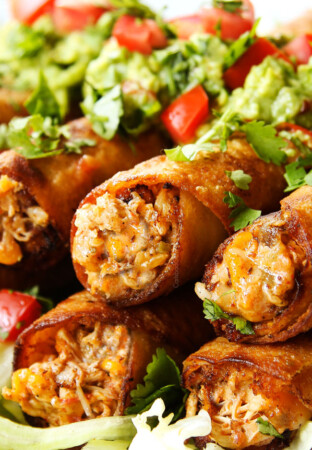
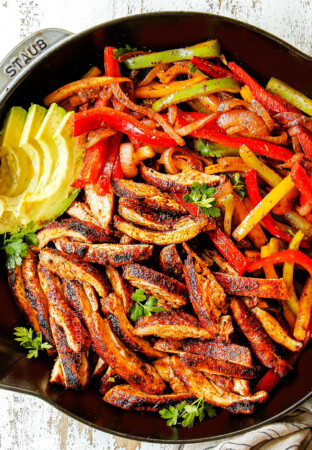

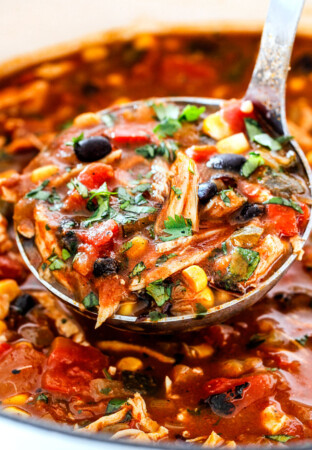
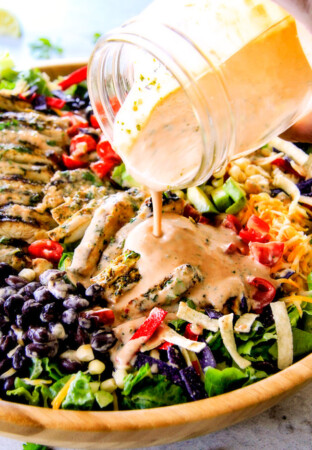
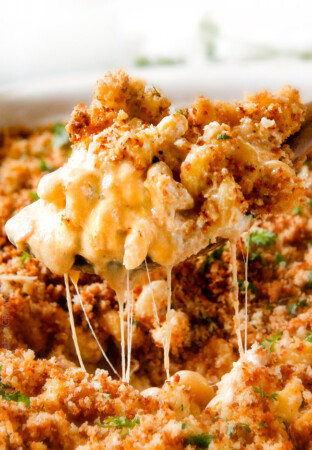

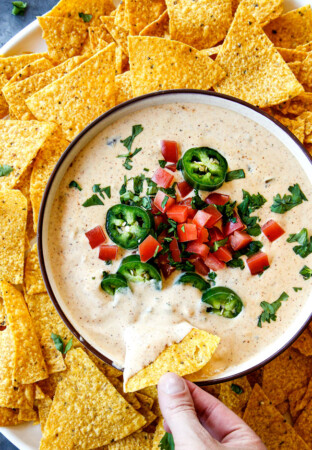
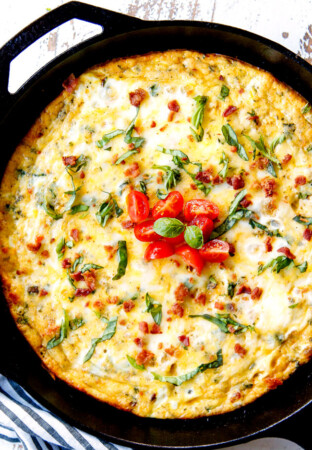
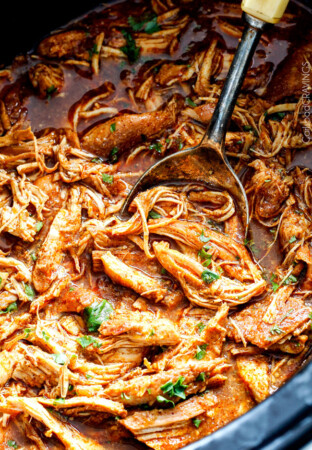
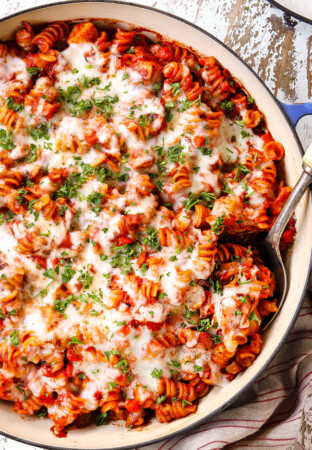
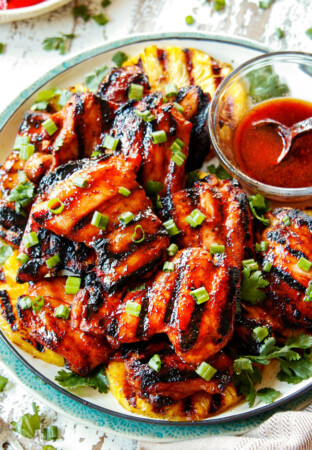
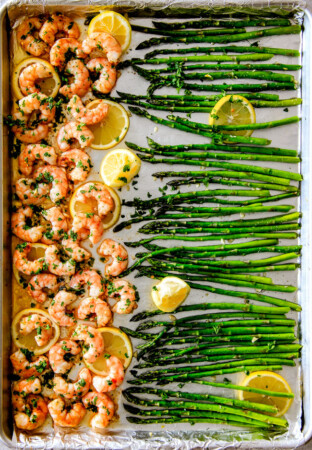

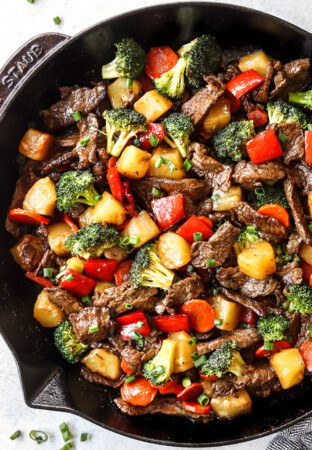
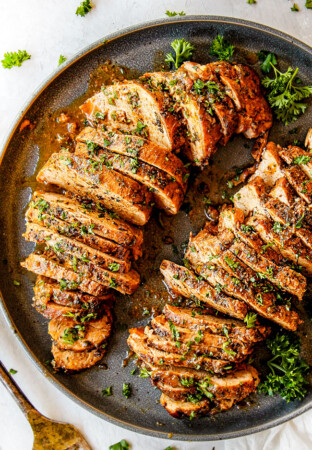
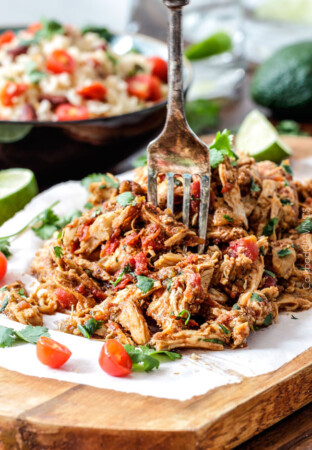
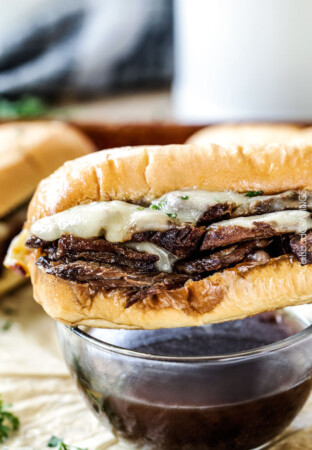
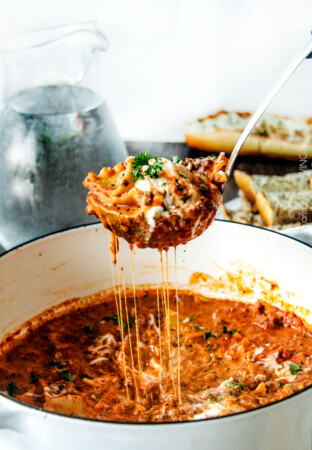
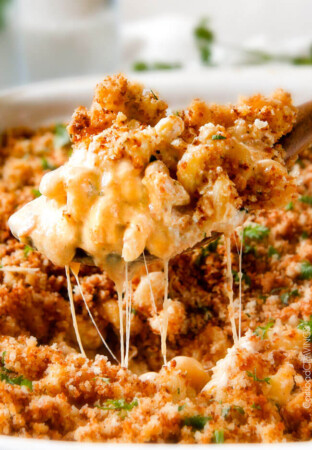
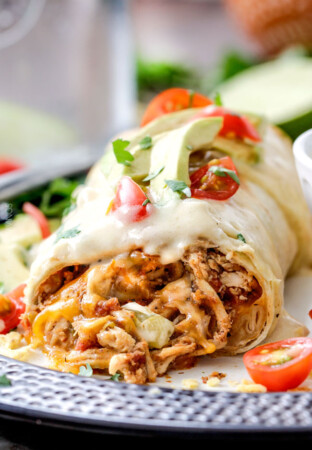
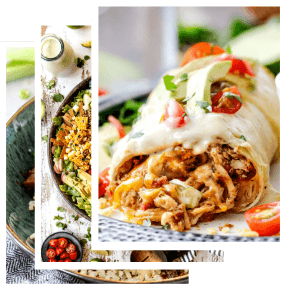
Catherine says
I made this last night and it was absolutely incredible! We went to Thailand for our honeymoon and are always on the lookout for authentic tasting recipes. I accidentally forgot the tomatoes and I made it vegetarian by topping with a fried egg and omitting the chicken. But other than that, I followed the recipe to a T. The sauce was amazing and the trip to the Asian grocery store was totally worth it for some Thai basil and fresh wide rice noodles! Can’t wait to make it again (next time with the tomatoes)!
Jen says
Thank you so much for taking the time to comment Catherine! It’s rare readers have actually eaten Thai food IN Thailand, so I’m extra flattered you loved this recipe!
Jennifer Fulk says
Hi Jen. For the Bird’s Eye chiles are you using the fresh or dried? I was looking on Amazon and they also have Birds Eye chili pepper in powder form Would that work in this?
Jen says
Hi Jennifer, I am using fresh Birds Eye Chilies for this recipe but you can use any of the substitutions in the notes. You can also absolutely use the powder on Amazon – they probably tell you what the equivalent to one chili is on the bag. Good luck!
Chris Maurer says
This sauce provided the most authentic pad kee mow flavor of any I have tried, and I have tried a few. The pre-soaking of the meat is brilliant, producing brown, crispy edges and tender inside.
After watching a few YouTubes of Thai street vendors I used your ingredients but their stir-fry technique. 1. Soak your dry rice noodles in ice water at the start of your prep. 2. Get your oil as hot as you can for your meat – when the street vendors add the meat it flames up. After the meat starts to char, add the onions. When cooking is finished, remove the meat and onions and turn off the heat. 3. Off-heat add in the chilis and garlic together, turn heat back to medium high, drain and add noodles, spooning in water a little at a time as the noodles cook, stirring constantly. This way you control how done the noodles get. 4. Add vegetables, then sauce continuing to stir. When noodles are done, add back meat and onions and char your noodles over high heat. 5. Remove from heat and add basil, stirring until basil is just wilted.
None of the above changes the flavor of the dish, that comes from your great recipe. This just allows a little more control over the dish’s texture and doneness.
Jen says
Thanks Chris, I’m so pleased you loved it! Thank you also for your detailed technique, I’m sure other readers will find it helpful.
Brenda says
This was amazing! Smelled so good while making it and tasted like it came from a restaurant. I could not find wide noodles so I used the thickest rice noodles I could find. I didn’t put the chicken in it because I was already making the lemon grass chicken from the site and used this as a side. Will order the thick noodles from Amazon for the next time.
Jen says
Yay! I’m so thrilled it turned out so well!